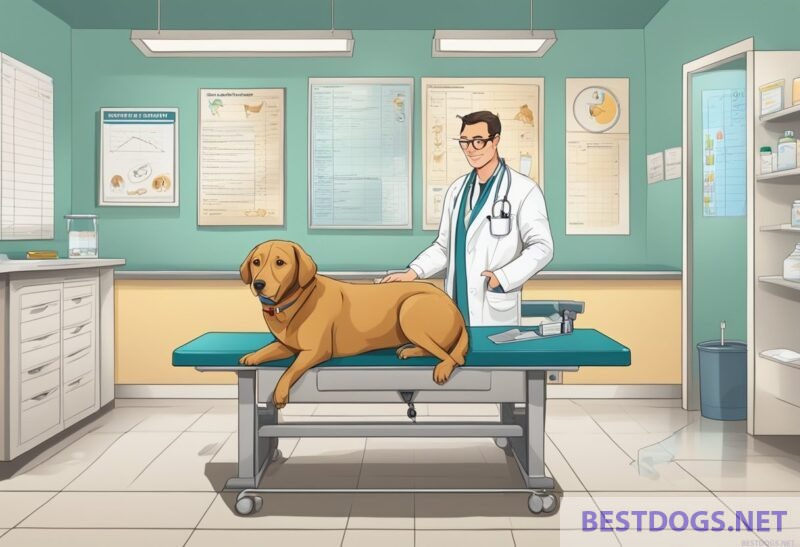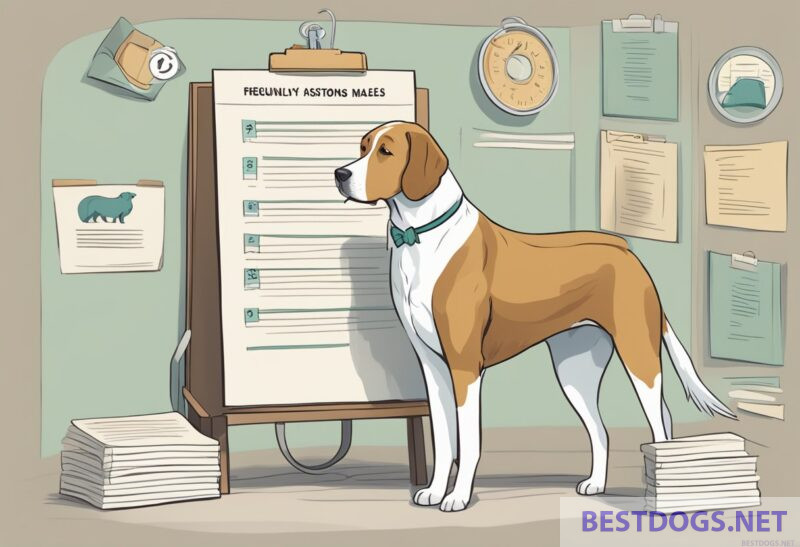Advantages and disadvantages of castrating male dogs.

Pros and Cons of Castrating Male Dogs: A Comprehensive Guide
Table of Contents
Castrating male dogs, commonly known as neutering, is a surgical procedure that involves the removal of the testicles. It is a widespread practice, recommended by many veterinarians and animal welfare organizations, primarily for population control and the health benefits it can offer.
Zesty Paws Multivitamin Treats for Dogs - Glucosamine Chondroitin for Joint Support + Digestive Enzymes & Probiotics - Grain Free Dog Vitamin for Skin & Coat + Immune Health - Chicken Flavor - 90ct
$29.97 (as of April 15, 2024 21:31 GMT +03:00 - More infoProduct prices and availability are accurate as of the date/time indicated and are subject to change. Any price and availability information displayed on [relevant Amazon Site(s), as applicable] at the time of purchase will apply to the purchase of this product.)Virbac CET Enzymatic Toothpaste| Eliminates Bad Breath by Removing Plaque & Tartar Buildup | Best Pet Dental Care Toothpaste | Poultry Flavor, 2.5 oz tube
$10.99 (as of April 15, 2024 21:31 GMT +03:00 - More infoProduct prices and availability are accurate as of the date/time indicated and are subject to change. Any price and availability information displayed on [relevant Amazon Site(s), as applicable] at the time of purchase will apply to the purchase of this product.)SHEBA PERFECT PORTIONS Paté Adult Wet Cat Food Trays (24 Count, 48 Servings), Signature Seafood Entrée, Easy Peel Twin-Pack Trays
$25.98 (as of April 15, 2024 21:31 GMT +03:00 - More infoProduct prices and availability are accurate as of the date/time indicated and are subject to change. Any price and availability information displayed on [relevant Amazon Site(s), as applicable] at the time of purchase will apply to the purchase of this product.)The decision to neuter a male dog can come with a variety of implications for the dog’s health, behavior, and overall well-being.
The benefits of neutering include a reduced risk of certain health problems, such as testicular cancer and prostate disease. It also curtails reproductive-driven behavior such as marking territory, aggression, and the compulsion to roam in search of a mate.
This contributes to fewer stray animals and reduces the risks associated with fights or accidents during roaming.
However, there are also potential drawbacks that dog owners should consider.
Neutering can lead to a propensity for weight gain due to a slower metabolism, and it may increase the risk of other health issues such as certain types of cancer and orthopedic problems.
The timing of the procedure can also play a critical role, as there is growing evidence that the age at which a dog is neutered may affect its health later in life.
Thereby, it’s essential that pet owners weigh the pros and cons of neutering a male dog and consult with their veterinarian to make an informed decision that best suits their individual dog’s needs.
Understanding Castration
Castration is a commonly performed procedure on male dogs that can affect a range of behaviors and physical processes. This section will explore the fundamental aspects of castration, including the definitions and preferred timings associated with this surgical procedure.
Definitions and Terminology
Castration, often interchangeably referred to as neutering or fixing, is a surgical procedure in male dogs that involves the removal of the testicles.
By castrating a dog, the production of testosterone, a major sex hormone, is significantly reduced, thereby impacting the dog’s reproductive ability and potential behavior linked to hormonal influences.
- Surgical castration: Involves the physical removal of the testicles.
- Chemical castration: Utilizes injections to reduce testosterone levels without removing the testicles.

This leads to a form of sterilization, as the dog becomes unable to breed. The vas deferens, which are the ducts that carry sperm from the testicles to the urethra, are also disrupted or removed, ensuring the dog cannot sire puppies.
Appropriate Age for Castration

The appropriate age for castration can vary, with many veterinarians recommending the procedure be done from as young as six months to two years old, depending on the individual dog’s health, breed, and size.
If the procedure is carried out too early, before the dog is even mentally mature, this can lead to insecure and dependent behavior. Dogs that are castrated too early also grow larger and can later develop bone density problems.
It’s important that the dog is:
- Physically mature enough to handle anesthesia and surgery.
- Young enough to benefit behaviorally and medically from the procedure.
Considering a dog’s general health and developmental stage is crucial when scheduling castration to ensure optimal outcomes both for behavioral adjustment and long-term health.
Health and Behavioral Benefits

If you have a female dog and live in a street with lots of male dogs, sterilization is definitely a good idea. It can also mean less stress for the owner of a male dog if, after neutering, he no longer behaves wildly when hot bitches run along the garden fence.
For years, one of my male dogs only reacted to the neighbor’s female dog when she was ‘in heat’. However, this was limited to just three days at a time, which was fine. But when he developed prostate problems at the age of nine and started leaking fluid, it was less fun.
Castrating male dogs offers specific health advantages such as a reduced likelihood of certain cancers and prostate disorders, and can elicit favorable changes in behavior. The procedure may lead to a decrease in aggression and other undesirable activities linked with a dog’s instinctual drives.
Mitigation of Health Risks
Castration is chiefly recommended to mitigate health risks. This surgical procedure removes the dog’s testicles, which effectively eliminates the risk of developing testicular cancer.
The absence of these organs also reduces the chance of certain forms of prostate disorders and limits the possibility of diseases like perianal fistula.
Additionally, some sources suggest neutering can lower the incidence of geriatric cognitive impairment, though concrete evidence might vary.
- Health Risks Mitigated by Castration:
- Eliminates risk of testicular cancer.
- Decreases likelihood of certain prostate disorders.
- Potentially lowers incidence of perianal fistula.
- May reduce risk of geriatric cognitive impairment.
Behavioral Improvements
From a behavioral perspective, the benefits of castrating male dogs are evident, albeit only slightly and decreasing with increasing age when the procedure is carried out.
The procedure often leads to a reduction in aggression, which can be seen in the decrease of dominance-related behaviors, including territorial aggression and inter-male confrontations.
It also curtails other sexual behaviors such as humping.

Neutering may diminish tendencies associated with anxiety and hyperactivity by removing the hormonal influence of testosterone, and lead to a more balanced and calmer dog.
Moreover, neutering a male dog can lead to decreased roaming in search of mates and can prevent obesity by reducing a dog’s overall energy requirements.
- Behavioral Improvements Through Castration:
- Reduced aggression and dominance behaviors.
- Decreased sexual behaviors, such as humping.
- Possible decrease in anxiety and hyperactivity.
- Lower propensity to roam for mating purposes.
- Can help prevent obesity by managing energy needs.
Risks and Considerations
When considering the castration of a male dog, it’s important to weigh the potential surgical risks as well as the necessary post-surgery care. Castration can mitigate several health and behavioral issues, but it also comes with inherent risks and the need for diligent aftercare.
Surgical Risks
- Anesthesia-Related Complications: The use of general anesthesia is necessary for a safe and pain-free castration procedure. However, it introduces risks such as an adverse reaction which can lead to stress on the body or, in rare cases, death.
- Intraoperative Issues: During surgery, unforeseen challenges such as bleeding or sensitive reactions to materials used can occur. Although rare, such complications can lead to anxiety and pain for the dog.
Post-Surgery Care
- Monitoring for Complications: After castration, it’s vital to monitor for any side effects like excessive swelling, signs of infection, or bleeding. Timely detection and intervention can prevent suffering and health risks.
- Management of Potential Side Effects: Dogs may experience weight gain due to changes in metabolism. Owners should adjust diet and exercise routines accordingly.
- Moreover, some dogs develop hypothyroidism or incontinence as long-term side effects of the procedure, which require ongoing management.
Impact on Dog’s Life
When it comes to the impact of castration on a male dog’s life, the two primary areas of concern are physical health and behavioral changes. Each aspect plays a significant role in the overall wellbeing of the dog and can bring about both positive and negative consequences.
Physical Health Factors
Castrating a male dog, commonly known as neutering, is a surgical procedure that can influence the dog’s physical health in several ways.
Neutering eliminates the risk of testicular cancer and can reduce the incidence of prostate disorders.
Furthermore, it’s acknowledged that neutering may affect a dog’s metabolism and reduce its overall exercise needs.
This can lead to an increased risk of obesity if calorie intake isn’t adjusted and exercise isn’t maintained appropriately.
- Testicular Cancer: Eliminated post-neutering.
- Prostate Disorders: Risk reduced.
- Weight Management: More challenging post-neutering due to potential metabolic changes.
- Diet: May require adjustment to prevent overweight issues.
Alterations to diet and consistent exercise are crucial to prevent weight gain and maintain a good quality of life.
It is essential for an owner to monitor their dog’s weight closely after neutering to prevent potential health issues related to obesity.
Left: Simba after the operation, during which he was also neutered.
Right: Simba 16 weeks later; his abdominal girth and weight have increased significantly after neutering, making a feed check necessary.
Behavioral and Social Factors
The behavioral impacts of neutering can be quite profound in male dogs.
It frequently results in a reduction in sexual behaviors, such as mounting and roaming, which in turn can contribute to population control.
Additionally, neutering may decrease urine marking in the household and lessen aggressive tendencies, potentially resulting in a calmer demeanor.

- Sexual Behavior: Typically reduced.
- Aggression: May be lessened, but not guaranteed.
- Urine Marking: Often decreased in frequency.
However, neutering doesn’t change a dog’s fundamental personality or confidence, and it’s not a guaranteed solution for all forms of aggression in dogs.
The best age to neuter a dog can vary; consulting with a veterinarian is crucial to make an informed decision about when, or if, to neuter a dog, taking into consideration their specific health needs, breed, and lifestyle.
Practical Aspects of Castration

When considering the castration of male dogs, owners must evaluate the financial impact and long-term care requirements that this procedure demands.
The decision should be made with a clear understanding of the costs involved and necessary lifestyle adjustments for the dog’s post-surgical health and well-being.
Cost Analysis
Castration of male dogs typically entails a one-time surgical fee that can vary depending on the breed’s size, the dog’s age, the veterinarian’s fees, and any additional medical requirements such as dealing with cryptorchidism, where a testicle hasn’t descended.
Owners should expect to pay anywhere from $50 to $400 for the procedure.
This upfront cost guards against the potential expense of raising an unplanned litter of puppies and may contribute to long-term health benefits, such as a reduced risk of certain types of cancers.
In some cases, owners may need to purchase a buster collar to prevent the dog from interfering with the healing process post-surgery.
Long-Term Management
The adjustment to a dog’s diet and exercise regime post-castration is essential to mitigate the risks of obesity.
A neutered dog’s metabolism can slow down, necessitating fewer calories and smaller portion sizes.
Since castration can lead to coat changes, owners may need to provide additional grooming.
Due to the removal of testosterone, changes in behavior such as territory marking may be observed; these shifts typically contribute to a more amiable disposition within the species.
Furthermore, pet owners must ensure their dogs get proper exercise to maintain a healthy weight and prevent weight-related health issues.
A veterinarian may recommend a specific diet formulated for neutered dogs to aid in weight management.
Castration of shelter dogs

Most animal shelters neuter their dogs before they start placing them. Others give guarantees or mandatory requirements for neutering for dogs that cannot currently be neutered before they are placed.
Many of the placement organizations or clubs schedule calls and visits to ensure that the surgery has been performed. This is for the simple reason that the staff of shelters and rehoming organizations know only too well from their own experience that there are far more unwanted dogs than there are homes for them.
The impossibility of conception means that there are fewer dogs that are put down, surrendered or even killed.
However, sterilizing dogs just because they come from animal welfare is sheer nonsense, especially if it is not done at the right time.
For those of the readers who are unsure about the differences between males and females, it can be pointed out that sex characteristics tend to be altered by 50 to 60 percent by neutering.
Even if this were not the case, castration offers important health benefits.
A female dog is designed to have two pregnancies per year. If she does not become pregnant after one season, she may suffer a false pregnancy, making her unhappy and uncomfortable, which can lead to behavioral problems.
In addition, it is estimated that up to half of unspayed bitches contract a uterine infection called ‘pyometra’, which can be fatal.
Sterilization not only eliminates this risk, but also protects against mammary cancer if performed early enough.

Ethical and Reproductive Implications
Castration of male dogs presents critical questions around ethical treatments and reproductive outcomes, including the responsibility of breeders and the pervasive issue of dog overpopulation.
Responsible Breeding
Breeding practices influence the well-being of specific dog breeds and the broader canine gene pool.
Ethical breeding requires careful consideration to avoid unwanted pregnancies and ensure the health of both the mother and resulting puppies.
Castration can serve as a tool for breeders to prevent accidental litters and focus on planned, quality breeding strategies that emphasize the health and the preservation of the species.
However, it also removes the dog’s reproductive ability, which could be argued as interference with the animal’s natural life processes.
Ensuring male dogs are mature before castration is essential, as early neutering can affect their development.
Contribution to Dog Population
Population control is paramount to address the surplus of unwanted dogs and to reduce the strain on shelters.
Castration of male dogs contributes to this effort by preventing unplanned litters.
A single unneutered male can significantly increase the local dog population by contributing to multiple litters.
Additionally, reducing the population helps alleviate problems like an enlarged prostate, common in older dogs, and cryptorchidism, a condition where one or both testicles fail to descend.
While spaying females is more effective in preventing pregnancies, neutering males plays a vital role in responsible ownership and population control for the species.
Moreover, it can aid in preventing certain prostate problems and reduce the output of male hormones that can drive territorial and aggressive behaviors.
Frequently Asked Questions

Neutering or castrating male dogs is a significant decision for pet owners, with implications for behavior, health, and overall well-being of the dog. Here are some commonly asked questions that shed light on the various facets of this veterinary procedure.
What are the behavioral changes in male dogs after neutering?
After neutering, male dogs often exhibit reduced aggression, less marking territory with urine, and a decrease in roaming and mounting behaviors.
However, castration is not a guaranteed solution to all behavioral problems.
At what age is it considered too late to neuter a male dog?
It is rarely too late to neuter a dog, as the procedure can be beneficial at almost any age.
However, the procedure might carry more surgical risks for older dogs, similar to any surgical procedure in older animals.
What are the potential health risks associated with neutering male dogs?
Neutering male dogs can lead to certain health risks such as obesity, joint disorders, and some cancers, although it significantly reduces the risk of testicular cancer and some prostate disorders.
How could neutering a male dog potentially be considered inhumane?
Some argue that neutering could be considered inhumane if it’s done without considering the individual dog’s health or temperament, or if it is performed at an inappropriately young age, leading to potential developmental issues.
What are the arguments against neutering male dogs?
The main arguments against neutering involve the potential for negative health ramifications, impact on the dog’s natural development and behavior, and the belief that responsible management can prevent issues such as unwanted litters or aggressive behaviors.
What is the optimal age for neutering a male dog to ensure the best health outcome?
The optimal age for neutering can vary based on breed, size, and health but is generally considered to be after the dog has reached physical maturity.
The consensus among many veterinarians is to assess each dog individually to ensure the best health outcomes from the procedure.









